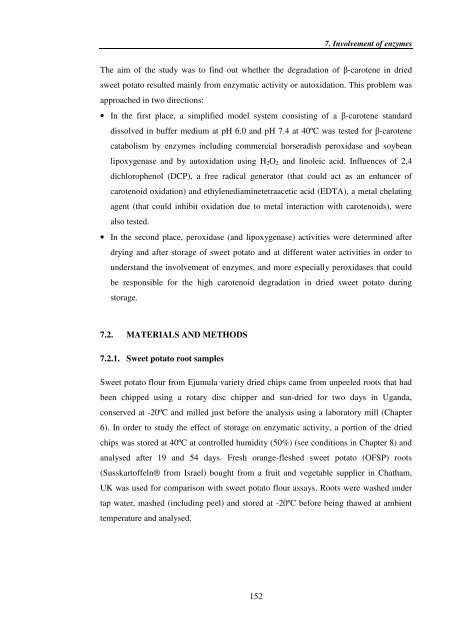Investigating carotenoid loss after drying and storage of
Investigating carotenoid loss after drying and storage of
Investigating carotenoid loss after drying and storage of
Create successful ePaper yourself
Turn your PDF publications into a flip-book with our unique Google optimized e-Paper software.
152<br />
7. Involvement <strong>of</strong> enzymes<br />
The aim <strong>of</strong> the study was to find out whether the degradation <strong>of</strong> !-carotene in dried<br />
sweet potato resulted mainly from enzymatic activity or autoxidation. This problem was<br />
approached in two directions:<br />
• In the first place, a simplified model system consisting <strong>of</strong> a !-carotene st<strong>and</strong>ard<br />
dissolved in buffer medium at pH 6.0 <strong>and</strong> pH 7.4 at 40ºC was tested for !-carotene<br />
catabolism by enzymes including commercial horseradish peroxidase <strong>and</strong> soybean<br />
lipoxygenase <strong>and</strong> by autoxidation using H2O2 <strong>and</strong> linoleic acid. Influences <strong>of</strong> 2,4<br />
dichlorophenol (DCP), a free radical generator (that could act as an enhancer <strong>of</strong><br />
<strong>carotenoid</strong> oxidation) <strong>and</strong> ethylenediaminetetraacetic acid (EDTA), a metal chelating<br />
agent (that could inhibit oxidation due to metal interaction with <strong>carotenoid</strong>s), were<br />
also tested.<br />
• In the second place, peroxidase (<strong>and</strong> lipoxygenase) activities were determined <strong>after</strong><br />
<strong>drying</strong> <strong>and</strong> <strong>after</strong> <strong>storage</strong> <strong>of</strong> sweet potato <strong>and</strong> at different water activities in order to<br />
underst<strong>and</strong> the involvement <strong>of</strong> enzymes, <strong>and</strong> more especially peroxidases that could<br />
be responsible for the high <strong>carotenoid</strong> degradation in dried sweet potato during<br />
<strong>storage</strong>.<br />
7.2. MATERIALS AND METHODS<br />
7.2.1. Sweet potato root samples<br />
Sweet potato flour from Ejumula variety dried chips came from unpeeled roots that had<br />
been chipped using a rotary disc chipper <strong>and</strong> sun-dried for two days in Ug<strong>and</strong>a,<br />
conserved at -20ºC <strong>and</strong> milled just before the analysis using a laboratory mill (Chapter<br />
6). In order to study the effect <strong>of</strong> <strong>storage</strong> on enzymatic activity, a portion <strong>of</strong> the dried<br />
chips was stored at 40ºC at controlled humidity (50%) (see conditions in Chapter 8) <strong>and</strong><br />
analysed <strong>after</strong> 19 <strong>and</strong> 54 days. Fresh orange-fleshed sweet potato (OFSP) roots<br />
(Susskart<strong>of</strong>feln® from Israel) bought from a fruit <strong>and</strong> vegetable supplier in Chatham,<br />
UK was used for comparison with sweet potato flour assays. Roots were washed under<br />
tap water, mashed (including peel) <strong>and</strong> stored at -20ºC before being thawed at ambient<br />
temperature <strong>and</strong> analysed.






